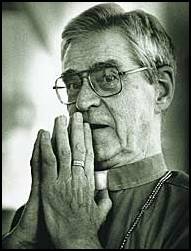Krister Stendahl
Krister Stendahl (21 April 1921 – 15 April 2008) was a Swedish theologian and New Testament scholar, and Church of Sweden Bishop of Stockholm. He also served as professor and professor emeritus at Harvard Divinity School.
That They Might All Be One, 1992, at the Massachusetts Council of Churches
Bio from Wikipedia, 1/4/2012
 Stendahl received his doctorate in New Testament studies from Uppsala University with his dissertation The school of St. Matthew and its use of the Old Testament (1954). He was later Professor at the Divinity School at Harvard University, where he also served as dean, before being elected Bishop of Stockholm in 1984. Stendahl was the second director of the Center for Religious Pluralism at the Shalom Hartman Institute in Jerusalem. After retiring in 1989, he returned to the United States, and was Mellon Professor of Divinity Emeritus at the Harvard Divinity School. He also taught at Brandeis University. Bishop Stendahl is an honorary fellow of the Graduate Theological Foundation.
Stendahl received his doctorate in New Testament studies from Uppsala University with his dissertation The school of St. Matthew and its use of the Old Testament (1954). He was later Professor at the Divinity School at Harvard University, where he also served as dean, before being elected Bishop of Stockholm in 1984. Stendahl was the second director of the Center for Religious Pluralism at the Shalom Hartman Institute in Jerusalem. After retiring in 1989, he returned to the United States, and was Mellon Professor of Divinity Emeritus at the Harvard Divinity School. He also taught at Brandeis University. Bishop Stendahl is an honorary fellow of the Graduate Theological Foundation.
Stendahl is perhaps most famous for his publication of the article “The Apostle Paul and the Introspective Conscience of the West”. This article, along with the later publication of the book Paul Among Jews and Gentiles, conveys a new idea in Pauline studies suggesting that scholarship dating all the way back to Augustine may miss the context and thesis of Paul. His main point revolves around the early tension in Christianity between Jewish Christians and Gentile converts. He specifically argues that later interpreters of Paul have assumed a hyper-active conscience when they have begun exegesis of his works. As a result, they have suggested an overly psychological interpretation of the apostle Paul, that Paul himself would most likely not have understood at all for himself.
Through his interest in the Jewish context of the New Testament, Stendahl developed an interest in Jewish Studies and was active in Jewish-Christian dialogue.
Stendahl is credited with creating Stendahl’s three rules of religious understanding, which he presented in a 1985 press conference in Stockholm, Sweden, in response to vocal opposition to the building of a temple there by The Church of Jesus Christ of Latter-day Saints. His rules are as follows:
- When you are trying to understand another religion, you should ask the adherents of that religion and not its enemies.
- Don’t compare your best to their worst.
- Leave room for “holy envy.” (By this Stendahl meant that you should be willing to recognize elements in the other religious tradition or faith that you admire and wish could, in some way, be reflected in your own religious tradition or faith.)
